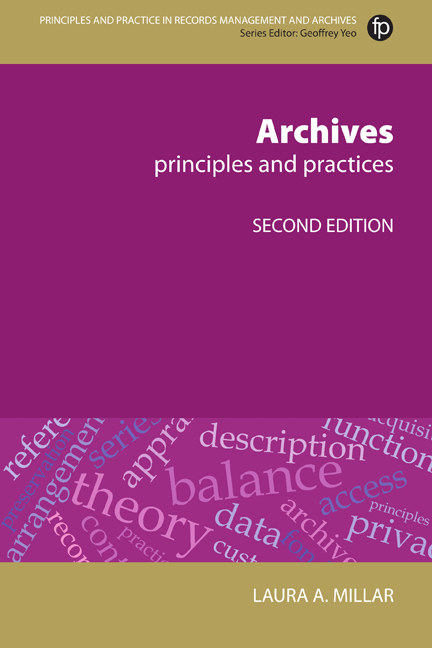Book contents
- Frontmatter
- Contents
- Figures and tables
- Foreword to the first edition
- Foreword to the second edition
- Acknowledgements
- Introduction to the second edition
- PART I ARCHIVAL PRINCIPLES
- PART II ARCHIVAL PRACTICES
- 8 Managing the institution
- 9 Preserving archives
- 10 Acquiring archives
- 11 Arranging and describing archives
- 12 Making archives available
- Conclusion
- To learn more
- Glossary of terms
- Index
- Miscellaneous Endmatter
10 - Acquiring archives
from PART II - ARCHIVAL PRACTICES
Published online by Cambridge University Press: 08 June 2018
- Frontmatter
- Contents
- Figures and tables
- Foreword to the first edition
- Foreword to the second edition
- Acknowledgements
- Introduction to the second edition
- PART I ARCHIVAL PRINCIPLES
- PART II ARCHIVAL PRACTICES
- 8 Managing the institution
- 9 Preserving archives
- 10 Acquiring archives
- 11 Arranging and describing archives
- 12 Making archives available
- Conclusion
- To learn more
- Glossary of terms
- Index
- Miscellaneous Endmatter
Summary
One cannot collect all the beautiful shells on the beach; one can collect only a few, and they are more beautiful if they are few.
Anne Morrow Lindbergh (1906–2001) Gift from the Sea, 1955How does an archivist decide which archives to acquire? How does she decide which specific items within a particular acquisition should be kept? Whatever an archivist decides to keep becomes valuable in large part because it has been kept. And whatever is not kept is, in the normal course of events, gone forever. Appraisal decisions can be daunting, to say the very least.
This is one reason appraisal is considered the most important and the most difficult aspect of archival work. If every record were valuable, and if every archivist had all the money and space in the world, there would, in theory, be no need for appraisal. The archivist could pack up all the documents in her care, put them in acid-free boxes or store them on a stack of computer hard drives and tell researchers to come and get them. Many archivists and digital experts are arguing this very idea, suggesting that with the unlimited capacity of cloud computing systems and the tremendous potential for research into ‘big data’, keeping more – in theory, keeping all – is easier and potentially more fruitful than ever before.
Others, and I count myself among them, prefer to think about Anne Lindbergh's seashells. What is the point in keeping everything? What is the point in trying? If archivists and society decide just to keep everything, how can we actually know which bit of information is core evidence and which is just dross that clutters our hard drives and our minds?
In order to cope with the challenge of deciding what to keep and what to reject, archivists have invented (and rejected and redefined and reinvented) a range of theories and principles surrounding the appraisal and acquisition of archival materials. Some of these approaches are highly objective, others exceedingly subjective.
- Type
- Chapter
- Information
- ArchivesPrinciples and Practices, pp. 179 - 212Publisher: FacetPrint publication year: 2017



